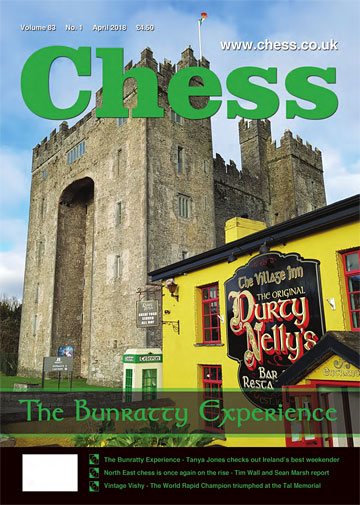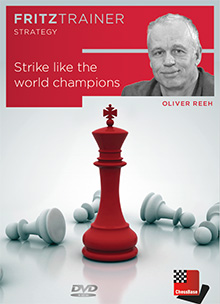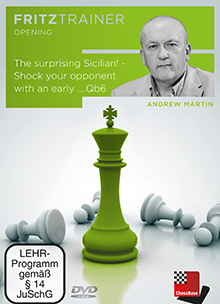


Players calculate ahead. They reach a given position and think about possible developments which lie in the immediate or long-term future. Study composers, on the other hand, usually think backwards. They imagine a fascinating and interesting position, then invest their time finding a unique line of play which would lead to it. For instance, the next position was conceived by a Dane, one of the best contemporary composers.
The astounding 1.Rb7!! forces victory, as will be explained shortly. Now, how can we reach the position? Think backwards...

[Event "1st prize, Rezvov-95 MT 2017"] [Site "?"] [Date "2017.??.??"] [Round "?"] [White "Nielsen, Steffen Slumpstrup"] [Black "White to play and win"] [Result "1-0"] [Annotator "Amatzia Avni"] [SetUp "1"] [FEN "2K5/8/3kp3/3P4/1R1Pp3/8/3pR3/3r4 w - - 0 1"] [PlyCount "11"] [EventDate "2017.??.??"] [SourceDate "2018.03.22"] [SourceVersionDate "2018.03.22"] 1. Kd8 {To avoid 1...Rc1+ 2.Kd8 d1Q.} e3 (1... Kxd5 2. Rb3 {will win eventually on material.}) 2. Rxe3 Re1 ({Or if} 2... Rh1 3. Rxe6+ Kxd5 4. Re5+ Kc6 5. Rc5+ Kd6 6. Rb6#) 3. Re5 $1 Rxe5 {White treatened 4.Rb6# [#]Now we have reached the position we started with.} 4. Rb7 $3 ({Not} 4. dxe5+ $2 Kxd5 5. Rb1 Kxe5 6. Rd1 Kf4 7. Rxd2 e5 {which draws.}) 4... Kxd5 ({Alternatively} 4... Rxd5 5. Rb6#) ({or} 4... exd5 5. Rb6#) ({or} 4... d1=Q 5. Rd7#) 5. Rd7+ Ke4 6. dxe5 {Halting the d-pawn and deciding matters.} 1-0
You probably know that you can move pieces on the replay boards to analyse, and even start an engine to help you. You can maximize the replayer, auto-play, flip the board and even change the piece style in the bar below the board. At the bottom of the notation window on the right there are buttons for editing (delete, promote, cut lines, unannotate, undo, redo) save, play out the position against Fritz and even embed our JavaScript replayer on your website or blog!

Hovering the mouse over any button will show you its function
Here is a simple, unpretentious middlegame-like study. Staring at the diagram position, all chess players would contemplate, as their first candidate, the move 1.b8Q. In contrast, no self-respecting problemist would naively believe that queening the pawn is the solution. Because if it were, then the knight on h7 would be redundant, as it disappears immediately. A problem solver takes into account the considerations of the composer; he knows that he would not use an extra piece without a reason. Besides, 1.b8Q+ is an obvious, begged-to-be played move. As such, it is not the place to look for the solution. In composed works, surprise is a vital ingredient; the unexpected is the norm.

[Event "Phenix 2017"] [Site "?"] [Date "2017.??.??"] [Round "?"] [White "Amatzia Avni"] [Black "White to play and win"] [Result "1-0"] [Annotator "Amatzia Avni"] [SetUp "1"] [FEN "7k/1P1p1ppN/3r1p2/3R1P2/8/3r4/P1q3PP/4R2K w - - 0 1"] [PlyCount "11"] [EventDate "2017.??.??"] [SourceDate "2018.02.28"] [SourceVersionDate "2018.02.28"] 1. Ng5 $1 (1. b8=Q+ Kxh7 2. Qxd6 ({If} 2. Rxd6 Qd2 $1) 2... Qd2 $1 3. Qg3 $1 { combining attack and defence} Rxd5 $1 4. Qh3+ Qh6 {and Black escapes unscathed. }) 1... fxg5 2. b8=Q+ Kh7 3. Qxd6 ({Not} 3. Rxd6 Qd2 4. Rh6+ $1 gxh6 5. Qe8 Qxa2 {and Black is saved.}) 3... Qd2 4. Qg3 $1 Rxd5 5. Qh3+ {Now, due to the change in the pawn structure created by 1 Ng5, Black can no longer defend with 5...Qh6.} Kg8 6. Re8# 1-0
In the next position the sole winning idea seems to be to advance the e-pawn, otherwise the black king will rush to the centre and stop the pawn, but 1.e6 fails. A problemist will search for all sorts of ideas and would be willing to consider unlikely moves...

[Event "2nd prize, Tijdschrift 1937"] [Site "?"] [Date "1937.??.??"] [Round "?"] [White "Jan Hendrik Marwitz"] [Black "White to play and win"] [Result "1-0"] [Annotator "Amatzia Avni"] [SetUp "1"] [FEN "k7/8/2p5/4P3/4B3/6p1/8/2n3K1 w - - 0 1"] [PlyCount "11"] [EventDate "1937.??.??"] [SourceDate "2018.02.28"] [SourceVersionDate "2018.02.28"] 1. Bd3 $3 (1. e6 $2 {fails to} Ne2+ 2. Kf1 g2+ $1 3. Kxg2 (3. Bxg2 Ng3+) 3... Nf4+) 1... Kb7 ({After} 1... Nxd3 2. e6 {the pawn is unstoppable.}) 2. Bc4 $1 { Now the knight is locked in a cage.} Kb6 3. Kg2 Kc5 4. Kxg3 $1 ({There’s no need to rush with} 4. e6 $2 Kd6 $1 5. Kxg3 Ne2+) 4... Kxc4 5. e6 Ne2+ 6. Kh2 $1 {The only winning move.} (6. Kg2 {or Kh3 would be met by} Nf4+) (6. Kf3 $2 Nd4+ ) (6. Kg4 $2 Nc3 7. e7 Nd5 8. e8=Q Nf6+) (6. Kf2 $2 Nc3 7. e7 Ne4+ 8. Ke3 Nd6) 1-0
In a practical game, the more forces one has for devising an attack, the better. We all know the slogan ‘Let everyone (all the pieces) join the party’. In the field of composed studies, it is the other way round: economy is valued; superfluous pieces and pawns are regarded as flaws. The goal is to produce much content with small means.

[Event "2nd commendation, IRT 2016"] [Site "?"] [Date "2016.??.??"] [Round "?"] [White "Afek, Yochanan"] [Black "White to play and win"] [Result "1-0"] [Annotator "Amatzia Avni"] [SetUp "1"] [FEN "1K6/3kP3/1P6/8/8/3rp3/8/7R w - - 0 1"] [PlyCount "15"] [EventDate "2016.??.??"] [SourceDate "2018.02.28"] [SourceVersionDate "2018.02.28"] {Rook endings usually signify boring technical play, but not in the hands of a skilled and capable composer. Afek, a grandmaster of chess composition, demonstrates an imaginative tactical skirmish from an apparently barren position.} 1. b7 (1. Ra1 $2 Rb3 2. b7 Kxe7 {draws.}) 1... e2 (1... Kxe7 { loses to} 2. Rb1 $1 e2 3. Ka7 ({or} 3. Kc7) 3... Ra3+ 4. Kb6) 2. e8=Q+ $1 ({ and not} 2. Ra1 $2 {which would be met by} Re3 {and Black holds.}) ({or} 2. Re1 $2 Re3) 2... Kxe8 3. Ra1 $1 Rd1 ({An exciting side-variation is} 3... Kd7 4. Ka8 $1 Rd1 5. Ra7 $3 {and White wins after} e1=Q 6. b8=Q+) 4. Kc7 $1 e1=Q ({ Or if} 4... Rxa1 5. b8=Q+ Kf7 6. Qb3+) 5. b8=Q+ Ke7 {forced,} ({as} 5... Kf7 6. Qb3+ {wins}) {Now White reveals his star point:} 6. Qd8+ $3 Rxd8 7. Rxe1+ Kf7 8. Kxd8 1-0
There are no long-term positional considerations in studies and problems. You will find no Carlsen-like endless manoeuvres to break the opponent’s balance, no shifting of forces to and fro, checking the rival’s patience. The play is not directed toward putting pressure on a backward pawn, or exchanging one’s knight for the enemy’s bishop (or vice versa). Instead, it is concrete, tactical play, from beginning to end.

[Event "1st commendation, Schach 2010"] [Site "?"] [Date "2010.??.??"] [Round "?"] [White "Amann, Gunter"] [Black "White to play and win"] [Result "*"] [Annotator "Amatzia Avni"] [SetUp "1"] [FEN "8/3p2p1/q4b1p/2QP3k/3P4/6K1/B7/8 w - - 0 1"] [PlyCount "11"] [EventDate "2010.??.??"] [SourceDate "2018.02.28"] [SourceVersionDate "2018.02.28"] 1. d6+ Bg5 ({Forced, as} 1... Kg6 2. Bb1+ Kf7 3. Qd5+ Kf8 4. Bg6 {is decisive.} ) 2. Bf7+ g6 3. Bc4 $1 ({And not} 3. Bd5 $2 Bh4+ 4. Kh3 Qf1+ 5. Bg2+ Qf5+) 3... Qb5 $1 4. Qf5 $1 Qe5+ {The last joke. Maybe White will capture with the queen.. .} ({A stalemate defence is met with a counter-combination, so if} 4... gxf5 5. Bf7#) ({or} 4... Qxf5 5. Be2+ Qg4+ 6. Bxg4#) 5. dxe5 gxf5 6. Bf7# *
Part two of this article will follow shortly. You may want to think about the following position:
You are asked to look at the position and decide which is the most preposterous move White can play, one that most certainly will not lead to the black king being mated in two more moves. You will find the solution to the problem in the second half of the article.
 About the author
About the authorAmatzia Avni is an Israeli psychologist, a FIDE Master in both over-the-board play and composition. He is the author of numerous books, among them The Grandmaster’s Mind (Gambit 2004, Russian Chess House 2016), and The Amazing Chess Adventures of Baron Munchausen (Mongoose Press, 2011).
The above article was reproduced from Chess Magazine April/2018, with kind permission.

CHESS Magazine was established in 1935 by B.H. Wood who ran it for over fifty years. It is published each month by the London Chess Centre and is edited by IM Richard Palliser and Matt Read. The Executive Editor is Malcolm Pein, who organises the London Chess Classic.
CHESS is mailed to subscribers in over 50 countries. You can subscribe from Europe and Asia at a specially discounted rate for first timers, or subscribe from North America.
UK’s most popular CHESS Magazine — established 1935! All the regular features of the UK’s best-selling CHESS magazine plus more! In this issue:
Download a free PDF preview of this issue!

 Strike like the World Champions
Strike like the World Champions
Oliver Reeh, PC-DVD; running time: 9 hours,
30 minutes
RRP £26.95 SUBSCRIBERS £24.25
The combination of Oliver Reeh and Wesley So might not have worked brilliantly in ChessBase’s Hamburg studio, but now we get to see the German IM and experienced presenter in his own right, and there will be no complaints about the length of this DVD. Reeh’s choice of subject is the most brilliant attacks and concluding combinations played by the 16 world champions, which are all presented in interactive format, meaning keen viewers can try and work out the solutions for themselves. Some of the games are rather well known, but plenty are not and the club player relatively new to the game, or looking for an inspirational refresher course, should be well educated by the wealth of sacrifices on offer which are largely clearly explained by Reeh.
Order online from
The London Chess Centre or Chess4Less (USA)
 The Surprising Sicilian – Shock Your Opponent with an early ...Qb6
The Surprising Sicilian – Shock Your Opponent with an early ...Qb6
Andrew Martin, PC-DVD; running time: 5 hours, 19 minutes
RRP £26.95 SUBSCRIBERS £24.25
Andrew Martin has certainly been busy of late and here promotes the Kveinys variation as an ideal weapon for the club player, as well as a surprise weapon for even stronger players. And what is the Kveinys? 1 e4 c5 2 Nf3 e6 3 d4 cxd4 4 Nxd4 Qb6 can lead to Scheveningen-type play, but ideally where White is away from the comfortable blanket of his or her knowledge of opening theory. At lower levels there are some pitfalls white players must avoid and even if they know their theory, the main lines are playable for Black, as shown by Peter Svidler and Judit Polgar.
Order online from
The London Chess Centre or Chess4Less (USA)
You can also find these products in the ChessBase Shop